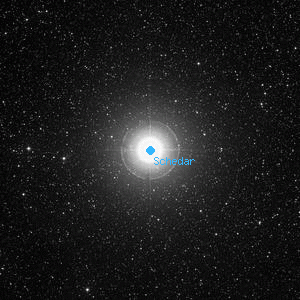Schedar

Overlaid DSS image of Schedar, 60' x 60' with north at top and west to the right
Aladin viewer for the region around Schedar
Alpha Cassiopeiae, α Cas, 18 Cas
BD+55 139, HD 3712, HR 168, WDS J00405+5632, SAO 21609, GSC 03663-02668, HIP 3179
BD+55 139, HD 3712, HR 168, WDS J00405+5632, SAO 21609, GSC 03663-02668, HIP 3179
| Type | Star |
|---|---|
| Magnitude | 2.23 | Right Ascension | 0h 40' 30.4" (2000) |
| Declination | 56° 32' 14" N |
| Constellation | Cassiopeia |
| Classification | K0-IIIa |
Observing Notes
Andrew Cooper
Nov 29, 2021 Waikoloa, HI (map)
20cm f/6 Newtonian, Cave Astrola @ 76x
Seeing: 7 Transparency: 6 Moon: 0%
Brilliant orange, a 9th magnitude companion is visible 1' west in rich galactic starfield
Hipparcos parallax data indicates that this companion is a background star
Captain William Henry Smyth
Nov 10, 1831 No. 6 The Crescent, Bedford, England (map)
150mm f/17.6 refractor by Tully 1827
A standard Greenwich star, with a companion. A 3, pale rose-tint; B 10½, smalt blue. This object is in the right breast of Dhát-al-Kursa, the Lady of the Throne; and it also obtained the names of Lucida Cassiopea, and Schedir ; the last being probably a corruption of Al-sadr, the breast, by the framers of the Alphonsine Tables. The Arabians having no passion for delineating the human form, made a dog of Cepheus, and its female of Cassiopea, retaining the Sedes Regia, or throne of the latter ; but the Canis foemina meant no disrespect.
The double star forms WH V 18, and was thus registered: Pos. 275°26' Dist. 56".17 Ep. 1781.97 which, compared with mine, does not show a greater difference of angle than might be expected from the proper motion of an object whose proximity is accidental. But the difference in distance is so remarkable, that it must be imputed to instrumental error, rather than that the acolyte is describing an ellipse round its primary. This acolyte must be the star alluded to by Piazzi, in Note O. 139, though he calls it the 9th magnitude, for the A Dec. 6' "78 makes "parumper ad boream."
Cassiopea, one of the ancient 48 asterisms, formed by five bright stars disposed something like an M, is a well-known circumpolar constellation, next to her husband Cepheus, and on the opposite side of the pole to the Great Bear. The earlier Arabians considered the whole as a large hand, of which the bright stars constituted the finger-points, and in which was even included the nebulous group in the left hand of Perseus.
Bayer thought the Hebrews called this asterism Ebn Ezra— "ein seltsamer Missgriff" exclaims Ideler: but Bayer had also seen in Juvenal's cathedra mollis, an allusion to Cassiopea's chair. It has been recorded as Al Thuraiyá, the many, a name more exclusively appropriated by the Pleiades: and it was once also called Carion, or the Laconian Key. The enumeration of its members increases, of course, as optical science advances, and successive ages have yielded these numbers:Ptolemy ..... 13 stars Hevelius .... 38 starsThere has been much idle discussion as to the orthography of this lady's name, whether it should be written Cassiopea, after the Latins, or Cassiepea from the Greek Kaooniireia; and the result has left either to the writer's choice utrum horum, &c. In the early illustrations to Hyginus, she is bound to her throne, or rather to a seat with a sort of gibbet-back, very much like the scaffold called i tre pezzi di legno by the Italians. Thus secured she cannot fall out in going round head downwards, pursuant to sentence.
Ulugh Beigh .. 13 Flamsteed ... 55
Tycho Brahé .. 46 Bode ........134
Sir William Herschel has tabulated the comparative lustre of the stars in this constellated group, and the statement will be found in the 86th volume of the Philosophical Transactions.
The distance of Shedir from Regulus, by Ptolemy, differs from that of modern astronomers by -23'37"; and the difference of latitude between it and α Trianguli is -3'33", on similar comparison.
Shedir is actually a variable star, though its usual aspect is that of a sharp, clear, third degree. WH's observations in 1796, make α and γ of the 3rd magnitude, and β 3.2 in lustre of the stars in Cassiopea; and its brightness is marked γ in Ptolemy.
Certainly when H. called my attention thereto, it was smaller than β or γ of the same constellation, "That the fluctuation in splendour of this star," writes H., " should have heretofore escaped notice, is not extraordinary, since the difference between its greatest and least brightness can hardly be estimated at so much as half a magnitude." Its period is stated at about 200 days ; but in July, 1839, it was positively brightening and better defined than the other two.
To find this star from the northward, project a ray from Alioth, through the Pole-star, and it will pass through the middle of Cassiopea, at nearly an equal distance on the other side of the pole. The circumvolution is well marked; when Ursa is at its lowest position below the pole, Cassiopea is near the zenith, and vice versa. If Shedir is required from the southward, resort to the galley rhyme :From alpha Ceti, to the east
You'll mark on Cassiopea's breast,
of Al'mak, towering rise,
where Shedir decks the skies.― A Cycle of Celestial Objects Vol II, The Bedford Catalogue, William Henry Smyth, 1844
Other Data Sources for Schedar
Nearby objects for Schedar
Credits...
Drawings, descriptions, and CCD photos are copyright Andrew Cooper unless otherwise noted, no usage without permission.
A complete list of credits and sources can be found on the about page
Schedar